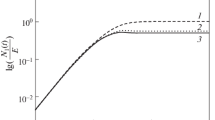Abstract
In the introduction some postulates on which the linear theory of viscoelasticity is based are recalled, and the postulate of passivity is substituted by a stronger postulate called detailed passivity.
Next, a symmetric formulation of this theory is presented which is founded in a well-balanced way on the limiting properties of elasticity and viscosity. This leads to the introduction of the basic functions of creep compliance J +(t) and stressing viscosity η+(t) associated to one another, whereas the basic functions retardation fluidity ϕ+(t) and relaxation modulus G +(t) emerge as their time derivatives. Correspondingly, four complex basic functions are defined as their Carson transforms.
In addition to the proper retardation and relaxation terms, these basic functions contain the non-disappearing constants of either instantaneous compliance J 0 or instantaneous viscosity η0 and also of either ultimate fluidity ϕ∞ or ultimate modulus G ∞. Therefrom ensues a classification of linear viscoelastic materials into four types: instantaneous elasticity or viscosity is allowed to combine with ultimate viscosity or elasticity. The latter alternative, signifying fluidlike or solidlike materials, leads, of course, to a quite different behavior in many situations; however, remarkable distinctive features are associated to the first one as well.
A few respective examples are outlined: 1) propagation of shear waves in a half-space with periodic and step-shaped excitation, 2) dissipation of work in a torsional vibration damper, and 3) shear flow between two parallel porous plates with injection and suction.
Finally, materials with viscous initial behavior are defended against the notion that they be of no or almost no real significance.
Similar content being viewed by others
References
Akyilditz F, Jones RS, Walters K (1990) On the spring-dashpot representation of linear viscoelastic behaviour. Rheol Acta 29:482–484
Brennan M, Jones RS, Walters K (1988) Linear viscoelasticity revisited. In: Uhlherr PHT (ed) Proc Xth Intern Congr Rheology, Vol 1, Sydney (Australia), Aug 14–19. Australian Soc Rheol, pp 207–209
DIN 13343 (1994) Linear-viskoelastische Stoffe: Begriffe, Stoffgesetze, Grundfunktionen. Beuth Verlag, Berlin
Giesekus H (1965) A symmetric formulation of the linear theory of viscoelastic materials. In: Proc IVth Intern Congr Rheology, Part 3, Providence (R.I., USA), Aug 25–30, 1963 Lee EH (ed) Interscience, New York, pp 15–28
Giesekus H (1970) Zur Formulierung der Randbedingungen in Strömungen viskoelastischer Flüssigkeiten mit Injektion und Absaugung an den Wanden. Rheol Acta 9:474–484
Giesekus H (1989) Several comments on the paper “Some remarks on ‘Useful theorems for the second order fluid’” by P. N. Kaloni. J Non-Newtonian Fluid Mech 33:343–348
Giesekus H (1994) Phänomenologische Rheologie — eine Einführung. Springer, Berlin
Author information
Authors and Affiliations
Additional information
Dedicated to Professor K. Walters on the occasion of his 60th birthday.
Delivered as a Plenary Lecture at the Fourth European Rheology Conference, Seville (Spain), 4–9 September 1994. The herein only outlined topics are taken from a recently pulished monograph (Geisekus, 1994) in which complete derivations of the results and more detailed discussions are given.
Rights and permissions
About this article
Cite this article
Giesekus, H. An alternative approach to the linear theory of viscoelasticity and some characteristic effects being distinctive of the type of material. Rheol Acta 34, 2–11 (1995). https://doi.org/10.1007/BF00396050
Received:
Accepted:
Issue Date:
DOI: https://doi.org/10.1007/BF00396050




